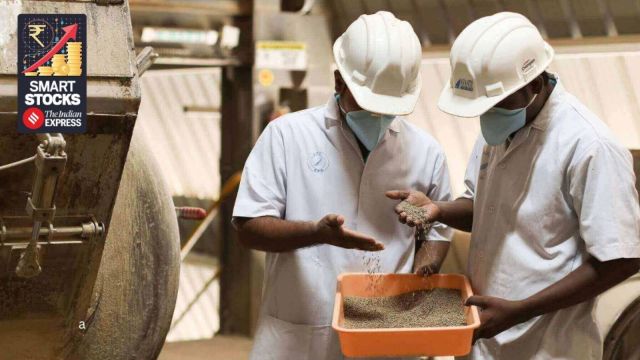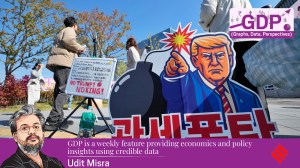Avanti Feeds: After 8 years of 0% returns, is the tide finally turning?
Avanti Feeds, India’s largest shrimp feed player, has struggled with profitability. However, an expansion in EBITDA margins for its shrimp feed segment has fueled a stock rally. But is this turnaround sustainable?
 Avanti Feeds generates 80 per cent of its revenue by supplying feed to farms across India. (Credit: avantifeeds.com)
Avanti Feeds generates 80 per cent of its revenue by supplying feed to farms across India. (Credit: avantifeeds.com)Avanti Feeds, India’s largest shrimp feed player with a market share of 50%, has struggled with profitability, achieving just a 5% CAGR in the past five years. However, recent quarters suggest a turnaround may be underway.
While the Nifty Smallcap 250 Index has dropped 20% from its September 2024 peak, Avanti Feeds stock has surged 20%.
 Fig 1: Source: http://www.tradinview.com
Fig 1: Source: http://www.tradinview.com
What’s driving this rally? Let’s take a closer look.
Business overview
Avanti Feeds operates in two key segments:
Shrimp feed (80% of revenue): Supplies feed to farms across India
Shrimp processing (20% of revenue): Procures from farmers and exports it to the US, Europe and the Middle East.
Let’s take a look at historical volume and price trends for both segments.
Shrimp feed: From 2018 to 2024, volumes grew at 3.8% CAGR, with a similar 3.8% YoY growth in the last nine months.
The revenue from this segment has grown at 7.2% between 2018 and 2024, and price has grown about 3.4% annualised during the same period. This is largely due to the excess supply from Ecuador, which has emerged as the largest shrimp exporter over the last decade.
Even on a nine-month basis, sales have increased only 3.34%, matching the volume growth over the period, suggesting there was no contribution to sales growth from price increases.
 Fig 2: Source: Avanti Feeds Ltd Investor Presentation Q3FY25
Fig 2: Source: Avanti Feeds Ltd Investor Presentation Q3FY25
With 80% of the total sales contributed by the shrimp feed segment, which is growing at 7.2% on a five-year basis and almost 0% on a nine-month basis, the outlook does not seem very appealing.
Shrimp processing segment: This segment, which accounts for about 20% of total sales, has grown at an annualised rate of 9.3% — from 786 MT to 1,344 MT between 2018 and 2024. 9MFY25 vs 9MFY24 saw a 4.7% increase. Revenue grew 11.3% from 2018 to 2024, pricing growth accounted for just 2%.
While neither segment shows impressive volume or price growth, could EBITDA margins be the force behind Avanti Feeds’ stock rally?
EBITDA margins
The EBITDA margin has expanded from 9% in Q3FY24 to 16.5% in Q3FY25 in the shrimp feed segment. Management attributes this to higher utilisation levels during Q3FY25 and decline in raw material prices.
 Fig 3: Source: Avanti Feeds Ltd Investor Presentation Q3FY25
Fig 3: Source: Avanti Feeds Ltd Investor Presentation Q3FY25
The margin expansion means that EBITDA for the feed segment has increased from Rs 83 crore to Rs 172 crore, more than double in just four quarters.
On the other hand, the EBITDA margins of the shrimp processing segment have contracted from 14% to 8% during the same period. Decline in the EBITDA margin for this segment in Q3 FY25 was partly due to an increase in raw material prices, higher ocean freight rate, and new plant depreciation.
 Fig 4: Source: Avanti Feeds Ltd Investor Presentation Q3FY25
Fig 4: Source: Avanti Feeds Ltd Investor Presentation Q3FY25
As a consequence, EBITDA margins for the shrimp processing segment have contracted sharply in the last few quarters despite the fact that global shrimp prices have improved between June and October 2024.
 Fig 5: Source: https://fred.stlouisfed.org/series/PSHRIUSDM
Fig 5: Source: https://fred.stlouisfed.org/series/PSHRIUSDM
Based on the above, it seems that the stock is reacting to improvement in EBITDA margins of the shrimp feed segment, which is showing strong signs of revival.
Is the surge in EBITDA sustainable?
In India, shrimp farming follows two primary seasons: the pre-monsoon crop (February-June), which benefits from stable water temperatures and optimal salinity levels, and the post-monsoon crop (August-November), which faces challenges such as freshwater intrusion and disease risks.
The pre-monsoon season sees the highest feed demand depending on expectations of supportive farm-gate prices. If this expectation is positive, farmer inquiries and stocking up feed and other raw materials (chemicals, probiotics, etc.) tend to go up for the upcoming season. This is also why Q1 of any financial year will tend to have the highest volume sales of shrimp feed.
 Fig 6: Source: Avanti Feeds Ltd Investor Presentation Q3FY25
Fig 6: Source: Avanti Feeds Ltd Investor Presentation Q3FY25
Global shrimp prices continue to rise, with Avanti Feeds shrimp processing realisations up 4% YoY in Q3FY25.
Given a continued increase in shrimp prices, demand for shrimp feed along with a strong upcoming Q1FY26 supported by higher EBITDA margins could lead to break-out earnings.
Valuations
P/E based valuations suggest that Avanti Feeds might be slightly overvalued. It is currently trading at 26X, about 25% higher than its 10 years median of 19.7X.
 Fig 7: Source: http://www.screener.in
Fig 7: Source: http://www.screener.in
While headline PE ratio seems to have run ahead of median valuations, it suggests that the market is expecting better than normalised profitability. An investor would have to be watchful of how volume and pricing shape up in the feed segment, barring which the stock can see sharp corrections as is typical of a commodity cyclical business.
Note: We have relied on data from http://www.Screener.in and http://www.tijorifinance.com throughout this article. Only in cases where the data was not available, have we used an alternate, but widely used and accepted source of information.
Rahul Rao has helped conduct financial literacy programmes for over 1,50,000 investors. He also worked at an AIF, focusing on small and mid-cap opportunities.
Disclosure: The writer or his dependents do not hold shares in the securities/stocks/bonds discussed in the article.
The website managers, its employee(s), and contributors/writers/authors of articles have or may have an outstanding buy or sell position or holding in the securities, options on securities or other related investments of issuers and/or companies discussed therein. The content of the articles and the interpretation of data are solely the personal views of the contributors/ writers/authors. Investors must make their own investment decisions based on their specific objectives, resources and only after consulting such independent advisors as may be necessary.



- 01
- 02
- 03
- 04
- 05



























